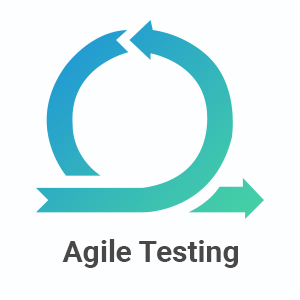


Agile Model shows an iterative and incremental approach. This approach breaks the product into small incremental units to provide iterations. Then each iteration involves steps like Planning, Requirement Analysis, Design, Coding, Unit Testing, Acceptance Testing, etc. This approach also allows continuous interaction with the customer for their feedback and corrections in the requirements at regular intervals. Agility is flexibility, it is a state of dynamic, adapted to the specific circumstances.
Agile Testing can begin at the start of the project with continuous integration between development and testing. Agile Testing is not sequential (in the sense it’s executed only after coding phase) but continuous.
An agile team works as a single team towards a common objective of achieving Quality. Agile Testing has shorter time frames called iterations (say from 1 to 4 weeks). This methodology is also called release, or delivery driven approach since it gives a better prediction on the workable products in short duration of time.
The agile test plan includes types of testing done in that iteration like test data requirements, infrastructure, test environments, and test results. Typical test plans in agile includes,
Agile testing life cycle spans through four stages, which are explained as follows.
The following steps are set to achieve in Iteration 0
The second phase of testing is Construction Iterations, most of the testing occurs during this phase. This phase is observed as a set of iterations to build an increment of the solution. To do that, within each iteration, the team implements a hybrid of practices from XP, Scrum, Agile modeling, and agile data and so on.
The goal of “Release, End Game” is to deploy your system successfully into production. The activities include in this phase are a training of end users, support people and operational people. Also, it includes marketing of the product release, back-up & restoration, finalization of system and user documentation.
After the release stage, the product will move to the production stage.
The agile testing quadrants separate the whole process in four Quadrants and help to understand how agile testing is performed.
a) Agile Quadrant I– The internal code quality is the focus in this quadrant, and it consists of test cases which are technology driven and are implemented to support the team, it includes
b) Agile Quadrant II– It contains test cases that are business driven and are implemented to support the team. This Quadrant focuses on the requirements. The kind of test performed in this phase is
c) Agile Quadrant III– This quadrant provides feedback to quadrants one and two. The test cases can be used as the basis to perform automation testing. In this quadrant, many rounds of iteration reviews are carried out which builds confidence in the product. The kind of testing done in this quadrant is
d) Agile Quadrant IV– This quadrant concentrates on the non-functional requirements such as performance, security, stability, etc. With the help of this quadrant, the application is made to deliver the non-functional qualities and expected value.
For more details visit: Connect Click2Cloud:
• Email us – contact@click2cloud.net
• See website – https://www.click2cloud.com/
• Watch our videos : https://www.click2cloud.com/videos-page.php?watch=60
• https://www.click2cloud.com/videos.php
• Past Events: https://www.click2cloud.com/past-events/past-events.php
• Codefest 2021: https://www.click2cloud.com/codefest/
• Read our Blog's – https://www.click2cloud.com/blogs.php
• Follow us on Twitter– https://twitter.com/click2cloudinc
• Find us on LinkedIn – https://www.linkedin.com/company/click2cloud-inc-
• Subscribe on YouTube – https://www.youtube.com/channel/UCjVgly_5QMuNZQh2I2FkHQQ
Agile testing involves testing as early as possible in the software development lifecycle. It demands high customer involvement and testing code as soon as it becomes available. The code should be stable enough to take it to system testing. Extensive regression testing can be done to make sure that the bugs are fixed and tested.